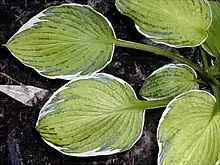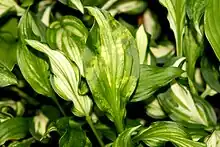| Hosta virus X | |
|---|---|
 | |
| Hosta 'Moonlight' cultivar infected with Hosta virus X | |
| Virus classification | |
| (unranked): | Virus |
| Realm: | Riboviria |
| Kingdom: | Orthornavirae |
| Phylum: | Kitrinoviricota |
| Class: | Alsuviricetes |
| Order: | Tymovirales |
| Family: | Alphaflexiviridae |
| Genus: | Potexvirus |
| Species: | Hosta virus X |
Hosta virus X (HVX) is a virus that infects hostas.[1] The disease was first identified in 1996 by Dr. Benham Lockhart at the University of Minnesota, and grouped with the Potato X (potex) viruses.[1][2] The virus has reached epidemic proportions and can be found in many garden centers and nurseries around the globe.[3]
Emergence
Hosta virus X began showing up in nurseries in the early 2000's. At first some people bought the infected hostas, believing that they were new cultivars of the plant.[3] Hosta cultivars such as "Break Dance," "Eternal Father," "Leopard Frog," "Blue Freckles," and "Lunacy" were not actual new cultivars, but instead were hostas infected with Hosta virus X that were mistakenly believed to be new cultivars.[3][4][5][6][7][8] Some of the infected hostas also made their way into European growers.[3]
Eventually, the virus reached the large growers in the Netherlands, and caused the virus to spread quickly.[3]
Signs and symptoms
Hosta virus X does not kill the plants infected, but hostas that have been infected do show a variety of other symptoms,[9] such as:
- Ink-bleed, which makes the plant look discolored in certain spots, and this effect is generally centered on a vein. An example of this is shown in the photo in this article.[10]
- Collapsed tissue, which can be signs of heavier infection, makes the leaf tissue look flattened and empty.[10]
- Mottling, which makes the plant appear blotchy. This is not always a symptom of HVX, and could be from another virus, but it should always be treated as a virus infected plant regardless.[10]
A hosta may no longer express symptoms of the virus when it grows back in the Spring, even though it may have shown symptoms in a previous year. Nonetheless, the plant should still be considered infected with HVX. A hosta infected with the virus may also be asymptomatic. Some plants in a study conducted by Dr. Lockhart at the University of Minnesota did not show symptoms for up to 3 years after testing positive for the virus.[11]

Control
The primary concern with HVX is its ability to spread prolifically.[12] Once a hosta plant is infected, it will be infected for the rest of its life. Any plant suspected of being infected should be burned if it is legal to do so. If it is not, then it should be tossed in the garbage, but infected hosta plants should never be composted. If any plant in a batch shows symptoms, the entire batch should be considered infected and be destroyed.
The virus primarily spreads through infected sap,[13] so dividing or cutting multiple plants by hand or with the same tool can spread the virus. Handling the roots also spreads the virus easily. Animals may also spread the virus through the sap by eating from an infected plant and then eating from an uninfected plant, though this has not been proven. Other unidentified vectors may exist.[9][14]
People who wish to buy hostas may request proof from the seller that the hosta is HVX-free before purchase. After purchase, even if test results come back negative for HVX, hostas suspected of being infected should be quarantined for a year or more away from other hostas and be observed to see if it presents any symptoms.[14]
Virus structure
The virus is about 530nm in length, and has a weight of 27 kDa. The virus shape is filamentous.[15]
References
- 1 2 Baker, Carlye (October 2013). "Hosta Virus X, a Potexvirus" (PDF). Plant Pathology Circular No. 410. Archived (PDF) from the original on 2021-06-03. Retrieved 2020-05-07 – via Florida Department of Agriculture and Consumer Services Division of Plant Industry.
- ↑ Park, M. H.; Ryu, K. H. (2003-10-01). "Molecular evidence supporting the classification of Hosta virus X as a distinct species of the genus". Archives of Virology. 148 (10): 2039–2045. doi:10.1007/s00705-003-0154-1. ISSN 1432-8798. Archived from the original on 2022-01-09. Retrieved 2021-04-17.
- 1 2 3 4 5 "Hosta Virus X - The History of the Epidemic". perennialnursery.com. Archived from the original on 2014-04-27. Retrieved 2020-05-07.
- ↑ "Hosta Photo Library". hostalibrary.org. Archived from the original on 2020-02-21. Retrieved 2020-07-20.
- ↑ "Hosta Photo Library". hostalibrary.org. Archived from the original on 2020-02-24. Retrieved 2020-07-20.
- ↑ "Hosta Photo Library". hostalibrary.org. Archived from the original on 2020-02-24. Retrieved 2020-07-20.
- ↑ "Hosta Photo Library". hostalibrary.org. Archived from the original on 2020-07-20. Retrieved 2020-07-20.
- ↑ "Hosta Photo Library". hostalibrary.org. Archived from the original on 2020-02-24. Retrieved 2020-07-20.
- 1 2 "Hosta Virus X". hostalibrary.org. Archived from the original on 2020-07-06. Retrieved 2020-07-22.
- 1 2 3 "Hosta Virus X Symptoms". hostalibrary.org. Archived from the original on 2020-01-30. Retrieved 2020-07-22.
- ↑ "Hosta Virus Myths | Walters Gardens, Inc". www.waltersgardens.com. Archived from the original on 2020-09-22. Retrieved 2020-12-05.
- ↑ "Hosta Virus X - Oklahoma State University". extension.okstate.edu. 2021-05-25. Retrieved 2023-04-03.
- ↑ "Hosta Virus X - Cooperative Extension: Insect Pests, Ticks and Plant Diseases - University of Maine Cooperative Extension". Cooperative Extension: Insect Pests, Ticks and Plant Diseases. Retrieved 2023-04-03.
- 1 2 "Hosta Virus X". Wisconsin Horticulture. Archived from the original on 2020-07-22. Retrieved 2020-07-22.
- ↑ Lockhart, B.E.L.; Currier, Sophie (1996). "VIRUSES OCCURRING IN THE HOSTA SPP. IN THE USA". Department of Plant Pathology, University of Minnesota: 62–67. Archived from the original on 2021-04-17. Retrieved 2021-04-17.
External links
Hosta Virus X by Megan Kennelly